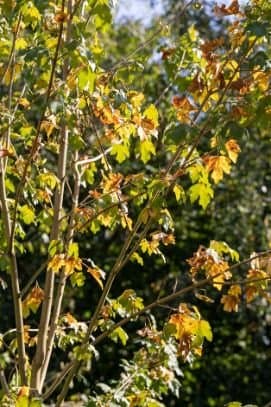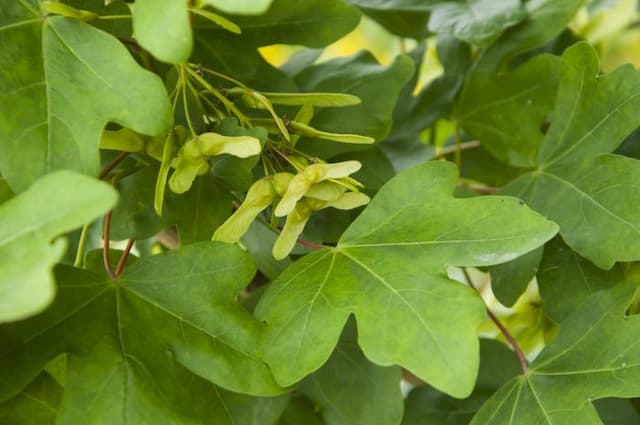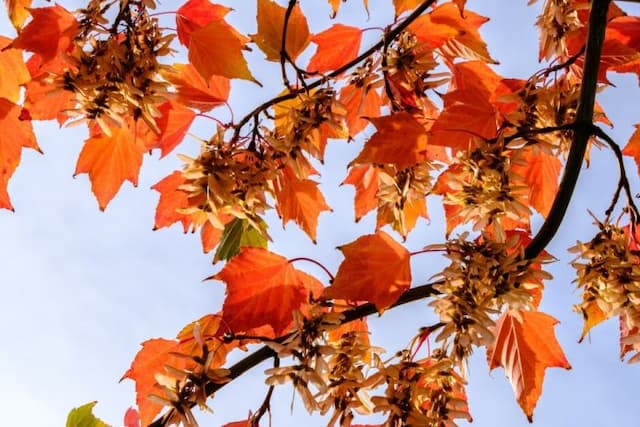Red Cappadocian Maple Acer cappadocicum 'Rubrum'

ABOUT
Acer cappadocicum 'Rubrum', also known as the Red Cappadocian maple, is a striking deciduous tree that is appreciated for its exquisite foliage and aesthetic appeal. This elegant maple variety boasts leaves that emerge with a deep red or purple tinge in the spring. As the leaves mature, they gradually transform into a lush, green color. Each leaf is palmate, meaning it resembles the palm of a hand with extensions out like fingers, typically with five lobes that radiate outward in a rounded shape. The Red Cappadocian maple's foliage is its most compelling feature, especially in autumn when the leaves display a magnificent show of colors. The fall brings a transformation as the leaves take on brilliant shades of red, gold, and orange, creating a spectacular seasonal display. Flowers of the Red Cappadocian maple are equally noteworthy, albeit less showy compared to its foliage. Small, delicate greenish-yellow flowers appear in the spring, often before or just as the leaves are unfolding. These are followed by the development of winged seeds, called samaras, which are quite common among maples. These seeds, sometimes referred to as 'helicopters', facilitate wind dispersal and add textural interest. The samaras of the Red Cappadocian maple typically possess a reddish tint on maturation, complementing the overall color scheme of the plant. The bark of this maple variety is another subtle feature, initially smooth and gray when young, but becoming more textured with age, adding to the character of the tree. The branches and twigs of the Red Cappadocian maple extend to create a pleasing shape, which greatly contributes to the tree's ornamental value throughout the year. Overall, the Red Cappadocian maple is an attractive tree favored in gardens and landscapes for its colorful foliage and pleasing form. It provides a year-round visual interest with the changing colors of the leaves, spring flowers, autumn hues, and architecturally pleasing structure.
About this plant
 Names
NamesFamily
Sapindaceae.
Synonyms
Red Cappadocian Maple, Red Maple.
Common names
Acer cappadocicum 'Rubrum'
 Toxicity
ToxicityTo humans
The Cappadocian maple, which Acer cappadocicum 'Rubrum' is a cultivar of, is not widely known to be toxic to humans. No significant toxin is reported in this species, and it is not commonly associated with human poisoning or allergic reactions. Ingesting parts of the Cappadocian maple typically does not result in any severe symptoms of poisoning and is generally considered safe around people with respect to toxicity. However, as with many plants, individual susceptibilities and allergic reactions cannot be entirely ruled out, so it is always prudent to avoid ingesting plant material that is not known to be edible.
To pets
The Cappadocian maple, which Acer cappadocicum 'Rubrum' is a variant of, has no reported toxicity to pets such as cats and dogs. The ingestion of this tree's leaves or seeds is generally not associated with any serious health problems for pets. However, as with humans, individual animals may have different sensitivities and while not toxic, it is not advisable for pets to consume plant materials not intended for their diet.
 Characteristics
CharacteristicsLife cycle
Perennials
Foliage type
Deciduous
Color of leaves
Varies
Height
40 feet (12 meters)
Spread
30 feet (9 meters)
Plant type
Tree
Hardiness zones
6
Native area
Southeastern Europe Western Asia
Benefits
 General Benefits
General Benefits- Ornamental Value: Acer cappadocicum 'Rubrum', also known as the Cappadocian maple, offers aesthetic appeal with its red or purple-tinted young leaves and attractive autumn coloration.
- Shade Provision: Mature Cappadocian maples provide shade, making them useful in parks, gardens, and urban landscapes.
- Wildlife Habitat: The tree can serve as a habitat and food source for various bird species and small mammals.
- Seasonal Interest: This maple species has seasonal changes that offer visual interest throughout the year, from leaf budding in spring to color changes in autumn.
- Diversity in Landscaping: The Cappadocian maple's unique features bring diversity to plantings, which is important for a balanced and interesting landscape design.
- Soil Erosion Control: Like many trees, the Cappadocian maple helps to prevent soil erosion with its extensive root system.
- Climate Adaptability: Acer cappadocicum 'Rubrum' is adaptable to a range of climates, which makes it a versatile choice for different geographic locations.
 Medical Properties
Medical PropertiesThis plant is not used for medical purposes.
 Air-purifying Qualities
Air-purifying QualitiesThis plant is not specifically known for air purifying qualities.
 Other Uses
Other Uses- Acer cappadocicum 'Rubrum', also known as Cappadocian maple, can be used in landscape photography due to its vivid red foliage, providing stunning visual contrast and enhancing the aesthetic quality of outdoor imagery.
- The wood of the Cappadocian maple can be utilized in fine woodworking for creating decorative items such as inlays or marquetry, offering a unique reddish hue to the craft.
- Dried leaves from the Cappadocian maple may be used in creating natural dyes for fabrics, yielding subtle color variations based on the mordant used.
- During autumn, the fallen leaves of the Cappadocian maple are collected for composting, turning into nutrient-rich soil additives for gardening applications.
- The strong and flexible branches can be used in basketry and other fiber arts, where they may be woven or braided into artistic forms.
- In bonsai art, Acer cappadocicum 'Rubrum' is valued for its naturally elegant branches and vibrant leaves, making it a prized species for miniature tree cultivation.
- Its distinctive foliage can serve as a natural indicator of seasonal change, making it useful for educational purposes in environmental science and phenology studies.
- The tree can be tapped for sap, similar to sugar maples, though it's less common, and the sap can be processed into a sweetener or syrup, albeit on a very small scale.
- Cappadocian maple tree bark features can be studied and appreciated in the field of dendrology, aiding in the understanding of tree growth and bark patterns.
- Leaves and smaller branches may be used in creative arts and crafts by children, teaching them about nature while they engage in making leaf rubbings or constructing miniature treehouses.
Interesting Facts
 Feng Shui
Feng ShuiThe plant Red Maple is not used in Feng Shui practice.
 Zodiac Sign Compitability
Zodiac Sign CompitabilityThe Red Maple is not used in astrology practice.
 Plant Symbolism
Plant Symbolism- Strength and Endurance: Acer cappadocicum 'Rubrum', commonly known as the Red Cappadocian Maple, typically symbolizes strength and endurance due to its hardy nature and ability to withstand various climates.
- Wisdom: Maples are often associated with wisdom, as they are long-living trees that watch over many generations.
- Balance: The balanced and symmetrical shape of the maple leaf can represent the idea of balance in life.
- Protection: In some cultures, maples are thought to offer protection and shelter, both physically with their canopy and spiritually with their presence.
 Water
WaterThe Cappadocian Maple, or 'Rubrum', prefers consistent moisture and should be watered deeply once a week during dry spells. It is important to avoid shallow watering; instead, provide the tree with about 15 to 20 gallons of water to ensure that the moisture reaches the deep roots. During the hot summer months, the frequency may need to increase to twice a week, especially if the weather is particularly dry or the tree is planted in well-draining soil. In contrast, reduce the amount of water during the winter when the tree is dormant. Always check the soil moisture before watering; the top inch of soil should be dry to the touch before the next watering session.
 Light
LightThe Cappadocian Maple thrives in full sun to partial shade. It is best to plant it where it can receive at least 4 to 6 hours of direct sunlight each day, combined with some dappled shade in the hotter parts of the afternoon. Avoid deep shade locations, as this will not provide the optimal light conditions for the tree's growth and leaf color development.
 Temperature
TemperatureThe Cappadocian Maple is hardy and can typically withstand a broad range of temperatures. It grows best in areas where the average temperature is between 50°F and 80°F. It can survive minimum winter temperatures down to around -20°F, while maximum summer temperatures should ideally not exceed 90°F for extended periods.
 Pruning
PruningThe Cappadocian Maple should be pruned for shape and health during the dormant season, ideally in late winter before new growth starts. Remove dead or damaged branches, those that cross or rub against each other, and any that disrupt the tree's natural form. Pruning every 2 to 3 years is typically sufficient to maintain its shape and encourage healthy growth.
 Cleaning
CleaningAs needed
 Soil
SoilCappadocian maple prefers well-draining, loamy soil with a pH of 5.5 to 7.5. The best soil mix can consist of two parts loam, one part sand or perlite, and one part organic compost or peat moss to ensure proper drainage and fertility.
 Repotting
RepottingCappadocian maple, being a larger tree species, does not typically require frequent repotting. It should be repotted every 3-5 years depending on growth rate and container size.
 Humidity & Misting
Humidity & MistingCappadocian maple tolerates a wide range of humidity levels and does not require high humidity, making it suitable for typical outdoor conditions where it can receive fresh airflow.
 Suitable locations
Suitable locationsIndoor
Place in bright, indirect light, ensuring ample space.
Outdoor
Full sun to partial shade, protected from harsh winds.
Hardiness zone
5-7 USDA
 Life cycle
Life cycleThe life of the Cappadocian maple (Acer cappadocicum 'Rubrum') begins with seed germination in spring, after the stratification period that breaks seed dormancy. The seedling stage follows, where the young plant develops its root system and the first set of true leaves. As a juvenile, the tree experiences rapid growth and establishes a more extensive root system and a sturdy trunk. During the maturation phase, the tree reaches reproductive maturity and begins to produce flowers, typically in mid-spring, followed by winged seeds known as samaras that disperse in the fall. Throughout its adult life, the Cappadocian maple will have annual cycles of growth, flowering, and seed production, often showing a vibrant red foliage in the autumn. The tree can live for many years, even centuries, until it eventually succumbs to environmental stresses, pests, diseases, or old age, completing its life cycle.
 Propogation
PropogationPropogation time
Spring-summer
The most popular method of propagating the Cappadocian Maple, scientifically named Acer cappadocicum 'Rubrum', is by seed. Seeds should be collected once they mature in the fall and then stratified for approximately 90-120 days at a temperature of 34 to 41 degrees Fahrenheit (1 to 5 degrees Celsius). This stratification process mimics natural winter conditions and helps break seed dormancy. After stratification, seeds can be sown in sterile soil at a depth of about 1/2 inch (approximately 1.25 centimeters). They require even moisture and warmth for germination. Seedlings will generally emerge in the spring if the conditions are conducive. As with most maples, patience is necessary as growth from seed can be slow and it may be several years before the seedlings reach a size suitable for planting out.









